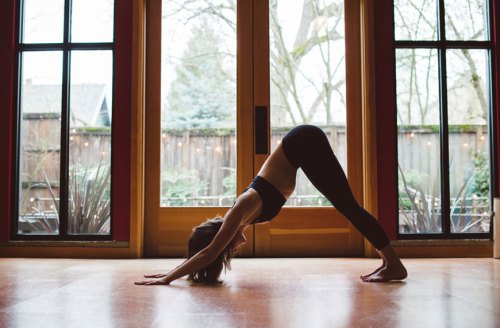The Most Common Mistakes People Make in Down Dog—And Exactly How To Fix Them
Are you doing down dog correctly? Here are the most common mistakes people make in downward dog (and how to fix them!), according to yoga instructors.

Downward dog seems simple enough. It’s typically one of the first poses you learn, and you do it in pretty much every class you take. But even longtime yogis might be making some of the most common down dog mistakes.
“At first glance, the down dog seems super easy and straightforward, but in truth, it’s a pretty technical pose when you practice yoga. Whether in a class or solo, you spend a fair amount of time coming in and out of a down dog, so it’s super important to master it,” says Corey Phelps, a yoga instructor and personal trainer. “When done properly, it stretches the hamstrings and calves, strengthens the arms, legs, back, and deep abdominal muscles that help stabilize the spine, and it can help relieve back pain.”
Little tweaks can help improve your alignment, make poses more comfortable, and make them easier on your body, and these are the most common mistakes to avoid in down dog—and how to fix them.
The most common mistakes you’re making in downward dog
1. Trying to force your heels to the ground
One of the biggest goals of down dog is getting your heels to the ground, but you shouldn’t ever force it. Instead of trying to get on the same level of that super-bendy girl in your class, instead focus on what feels good to you. That’s when you’re going to reap the most benefits.
“If you find that your heels are nowhere near the floor, that’s 100 percent okay,” Phelps says. “‘Heels on the ground’ is thought by many to be the gold standard, but it’s not. Some people will never be able to reach their heels to the ground in this pose. It could be structural or muscular, but that doesn’t mean they cannot or should not practice yoga. It probably means just the opposite—they need it the most.”
Solution: Instead of focusing on your heels, Phelps says to instead focus on lifting the hips up and back for a better stretch. “Soften the knees until they’re almost touching the ground, letting your heels lift away from the floor naturally. Then with your knees still bent, begin to push the hips toward the ceiling,” she says. “Note how the low back is now straight. Next, begin to straighten your legs at the knees. As soon as you feel your low back round, stop. Keep at least a small bend in the knees (or soft knees), then hold the pose and breathe.”
2. Locking out your knees
Many people think down dog involves locking out the knees. That’s not actually the case. “Any time a joint locks out, it allows the body to have a rest-stop, avoiding the essential surrounding muscular activation. With locked knees, pelvic mobility is lacking,” says Stacy Dockins, a yoga teacher and corrective exercise expert. Luckily, the solution couldn’t be easier.
Solution: If you keep a slight bend at your knee joints, Dockins says it really does your body good. “The pelvis has a bit more freedom to tilt up and back, bring more elongation and traction to the spine,” she says. “In my opinion, spinal traction is the most needed part of this pose for most people.”
3. Keeping your shoulders up near your ears
Phelps has an easy way to tell if your arms and shoulders aren’t placed properly during down dog. “Some people perform down dog like they’re wearing their shoulders as earrings,” she says. “This happens for two reasons: First, their shoulder blades aren’t engaged, which forces their upper arms to bear most of the burden of work. The arms fatigue more quickly, and as a result, the pose becomes less stable. This also causes the neck and shoulders to tighten. This is the exact opposite of the desired outcome this pose is trying to produce.”
Solution: To make sure your shoulders are positioned correctly, Phelps says to start with the arms. “Keeping your hands rooted on the ground, push through all five fingers and start to roll your upper arms out and downward. The insides of your elbows will rotate forward slightly,” she says. “Keeping that engagement in your arms, think of allowing the shoulders to sink into the sockets and the upper back becoming very broad as the neck and head reach long.”
Master other poses, too, by following this video:
Try these stretches to get your heels closer to the ground during down dog. Then use these yoga stretches to help your aching feet.
Sign Up for Our Daily Newsletter
Get all the latest in wellness, trends, food, fitness, beauty, and more delivered right to your inbox.
Got it, you've been added to our email list.










